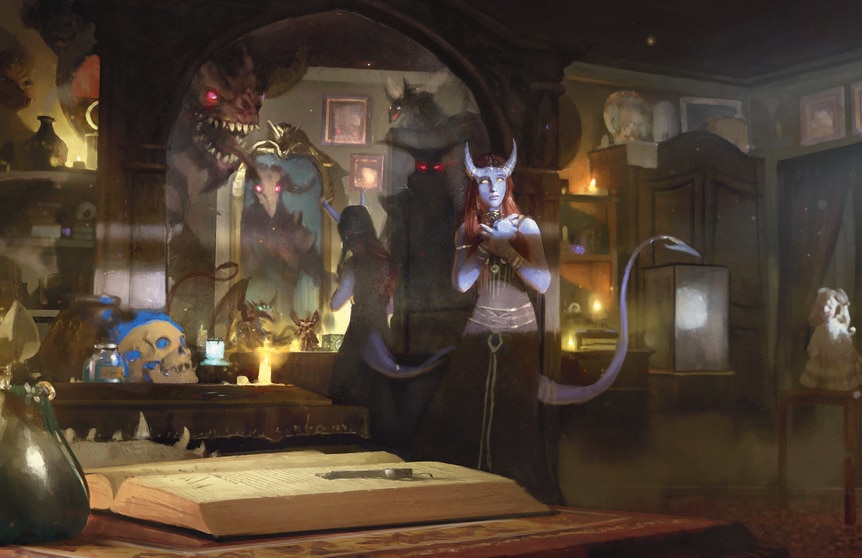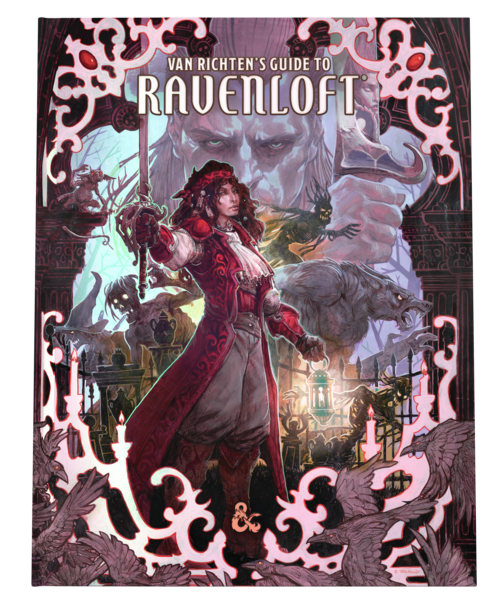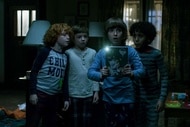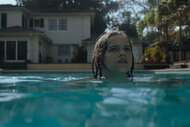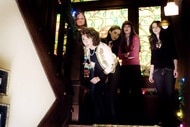Create a free profile to get unlimited access to exclusive videos, sweepstakes, and more!
D&D's next sourcebook is the game’s return to horror: Gothic, cosmic, psychological, and beyond

Dungeons & Dragons is basically synonymous with the fantasy genre, but the iconic tabletop game’s next sourcebook lets adventuring parties experience a whole new genre: horror. Van Richten’s Guide to Ravenloft, a 256-page book that fully introduces the classic D&D setting of Ravenloft to Fifth Edition and features new subclasses, races, and monsters, comes out on May 18.
Ravenloft, which has been part of D&D lore since the mid-’80s, is an otherworldly realm of various pocket dimensions, and each is rife with terrors and a grim Darklord presiding over their domain. Traditionally, Ravenloft has been all about gothic horror, best exemplified by Barovia, the setting of the popular Fifth Edition adventure Curse of Strahd, which has players attempt to take down the titular vampire lord. Van Richten’s Guide to Ravenloft, however, features 29 other Domains of Dread — and different flavors of horror.
“We’re starting with the core of Curse of Strahd and then expanding out from there into other domains of dread and beyond just gothic horror,” lead designer Wes Schneider told SYFY WIRE during a press pre-brief. Cosmic horror, body horror, folk horror, disaster horror, psychological horror, ghost stories, and some Egyptian-themed mummy spooks were just a few of the subgenres Schneider teased.
In addition to Barovia — which will not feel like a repeat of Curse of Strahd’s content, nor will that adventure be a mandatory prequel to Van Richten’s — the new book will bring back some other old Domains of Dread and give them a new polish. Lamordia is a Frankenstein-esque horror setting, as players will encounter the vile Dr. Viktra Mordenheim as she looks for an escaped creation named Alice. “This is mad scientists. This is flesh golems, this is horrible science gone wrong against a horrible snowy background,” Schneider said.
Dementlieu is a creepy fairytale masquerade that has “a Red Death-Cinderella vibe to it,” Kalakeri is based on Indian myth and folklore, pitting players between two rival factions, and Valachan is D&D meets The Most Dangerous Game, with the players as prey in a deadly rainforest.
Schneider cited Falkovnia as an example of a Domain they had updated in an effort to broaden D&D’s take on horror. Originally a Vlad the Impaler-type setting, Falkovnia is now a zombie apocalypse. “Ravenloft had never really had that before because it’s not really a gothic horror trope,” Schneider said, acknowledging that while a zombie has a paltry challenge rating of ¼ in the Monster Manual, “what happens when there are more zombies than there are fireballs?”
Beyond these and other pre-made Domains of Dread, Van Richten’s also contains the tools for Dungeon Masters to create their own Domains, with guidance on how to make a Darklord and tips for tailoring the various horror subgenre-options to their and the party’s liking.
Van Richten’s features two new subclasses and three new race options for players. Bards now have access to the College of Spirits subclass, allowing them to summon power by telling tales of old — possibly ghostly — spirits. Warlocks can take an Undead pact, making a deal with a litch or some other undead being in exchange for arcane power — and perhaps their own humanity. The new lineages are those of the Dhampir, the Hexblood, and the Reborn. Dhampir have some of the strength of a vampire without actually being a vampire, and Hexbloods are beings who have a connection to vile fey hags, and Reborn have been brought back from the dead in one way or another. All three lineages can be chosen during character creation, but they can also replace a character’s race during the course of the game, should they have a run-in with a vampire or meet their (temporary) demise.
Additionally, the new book will introduce Dark Gifts, ways that characters can be haunted that are both very much in keeping with Ravenloft’s horror flavor but also convey mechanical benefits. About 40 pages of the book focus on new, horrifying monsters.
Van Richten’s Guide to Ravenloft features plenty of characters old and new, including monster-hunter Rudolph Van Richten himself and Curse of Strahd’s Ezmerelda d’Avenir. A 20-page adventure called “House of Lament” is a classic haunted house tale and a fitting starting point to explore other Domains. In addition to Schneider, some of the horror pros who contributed to the book include Amanda Hamon, Cassandra Khaw, Molly Ostertag, and K. Tempest Bradford.
Notably, the new book will continue D&D’s attempts to move past damaging racial stereotypes, especially in regards to the Vistani, a traveling people whose portrayal in Curse of Strahd drew criticism for drawing on negative Romani tropes and stereotypes. Schneider said they worked with experts and cultural sensitivity advisers to make the Vistani into “a people who have a specific cultural experience.”
Van Richten’s Guide will also help guide DMs and players alike into creating a horror gaming experience that’s right for them, as there’s an in-depth section on “session zero” and creating a horror vibe that everybody is comfortable with. If your group wants to do a violent, hard-R horror gaming experience, that’s fine! As would be the choice to run a campaign where the horror is more like Scooby-Doo. Everybody just needs to be on the same page first.
“Horror roleplaying games are very different than horror video games or movies or whathaveyou,” Schneider explained. “A horror roleplaying game is much more personal and much longer. It also doesn’t have an off switch.”
Ultimately, Van Richten’s Guide to Ravenloft aims to be a blend of all sorts of horror tropes and the iconic fantasy roleplaying game.
“There’s tons of horror games out there,” Schneider said. “They are amazing! We’re not interested in aping those other games. We want to be D&D.”
Van Richten’s Guide to Ravenloft will be available on May 18.
